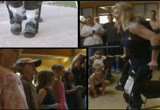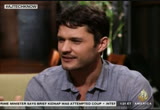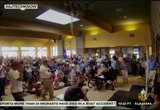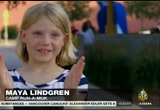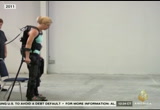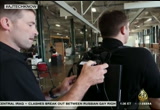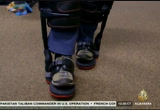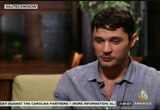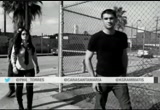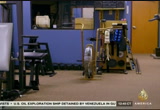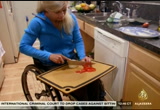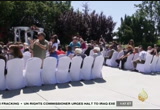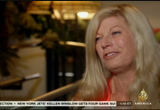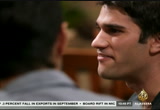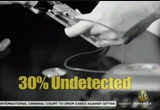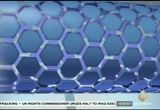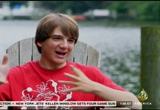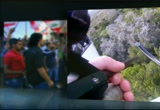tv Tech Know Al Jazeera October 12, 2013 1:30pm-2:01pm EDT
1:30 pm
welcome. i'm here to talk about innovations that change lives. we're going to explore the intersection between hardware and humanity. we're doing it in a unique way. this is a show about science by scientists. so let's check our team of nerds. phil torres studies insects in the rain forest of ecuador and peru. tonight our real-life spider-man takes us to colorado where iron man comes to life helping one woman stand tall despite a devastating disability. this is an engineering who designed a buy
1:31 pm
bionic eye. this young man invented a test to predict cancer. i'm a science major with a background in neurology. that's our team, and now let's do some science. we're back here at our favorite meeting place have been some coffee, and you guys did some incredible stories this week. it's interested to start out and hear about this exosuit for you, phil. >> the wheelchair was invented about 1500 years ago, so i'm sure we're due to an upgrade. this might be it, guys. check out this robot. this is where it's getting tested, but it's there on an actual person.
1:32 pm
i got to meet the test pilots that put these suits through their paces and some really amazing people. let's take a look. >> hi. >> this is a dream happening to them. >> these kids on a summer camp in aspen, colorado are about to give amanda a life changing gift to help her doing something she hasn't been able to do here since she was paralyzed in a horrific skiing accident 21 years ago. >> i want to invite the kids to just have at it and rip into it! >> it's a bionic robot called xo, a battery powered external skeleton that gives her legs the power to do this. >> are you ready? >> three, two, one. blast off!
1:33 pm
>> and this is -- >> i'm walking, guys! >> and even this. the technology is so cutting edge that amanda is the first person in the united states to own one. >> the moment she stood up, i was just amazed because she's been sitting down for 21 years, and that first feeling is to stand up again. i would have been thrilled to be in that position. >> it was an emotional moment for these kids, who spent the past year selling countless cups of lemonade and raising money from generous donors to make it happen. >> that was like my dream right there. all i wanted to see was her walk. it was amazing. >> for amanda, it was the culmination of a dream she's had
1:34 pm
ever since she was told she'd never walk again. >> the most profound moment was when i stood up, and i tried to see the children's faces. some of them, the really little ones, they were just in awe. then to have that heart-to-heart hug. when i hug in a wheelchair, there's a disconnect, and get heart-to-heart hugs when i stand up. >> can you promise me a standing hug? >> yes. >> okay, good. >> amanda took her first step to make that dream a reality in 2010. that's when she got a call from robot's creators asking her to be a test pilot for the new technology. she went to the san francisco bay area and took it for a test run. how did it feel to be able to stand and just look at people? >> the first time i
1:35 pm
stood up, i went home and i cried hard in all honesty. maybe it's the emotions that i had been dreaming about for so long, and i felt so good in my body. i slept hard. i wasn't in pain. >> total ending steps? >> 4,850. >> all right! >> so nice! >> the technology is fast hive moving and they're constantly coming out with something new. that's why i love flying back to california and saying, okay, bring it on. what am i going to try today? >> this is xo's headquarters where the magic is made and perfected. here robots like this are put through paces all to give people that are paralyzed a chance to
1:36 pm
do what they've been told is impossible. >> i feel like the luckiest man alive. >> nathan harding is a co-founder of xo bionics and one of the inventors. it was first developed for the battlefield as a device to help soldiers carry heavy loads long distances. >> there's a human thing in the military with soldiers getting injuries due to large loads they're carrying, and, in fact, they want to carry more. we were helped to develop xo skeletons to carry it. >> harding says the key break through is creating a wearable robot to support its own weight with a minimum of energy. that means it can be powered by a small battery pack, and then there's that whole walking thing. >> it takes over the function of the muscles in your legs, and it can do that either completely for like a person who is completely paralyzed below the
1:37 pm
waist or partially for someone maybe trying to relearn how to walk like someone who just had a stroke. >> i have to initiate the first step? like amanda, jason is an exo test pilot. >> i put the device in walk mode and then take the first right step. as i move my body, the exo will move with me. if i stop and don't go to the next position, the exo stops. so i can go forward and lateral, and there we go. we're walking again. >> in 2008 his spinal cord was injured in a motorcycle accident that almost killed him. jason says he found out he was paralyzed in a dream he had while he was in coma. it was his girlfriend, karen, who delivered the news. >> her message said this almost verbatim. hey, baby, it's me. you were in a bad motorcycle accident, and the doctors say you'll never walk again. if this isn't the life that you want to live, we understand and we'll let you go.
1:38 pm
if you want to stay and fight, i'll be here with you. i could hardly tell that story without tearing up, but i know that i've always been a fighter. so i wasn't going to give up. >> exo helped him battle to defy the odds. >> the first time i stood up in exo was just ridiculous. it was amazing. there's so many emotions going through it, and you have your fear of that. they're getting ready to blast off to space. >> test pilots like amanda and jason, how have they helped you guys advance this technology? >> oh, they've helped immensely, because everything is unpredictable once you introduce a human into the system. i remember being in the room with 13 ph.d.s and they all had
1:39 pm
a different idea of what would be the exact way to control something. without people like amanda and jason, we'd really be at a standstill, because we couldn't test anything. >> the first time i used the exo, the physical therapist was the only one that had control. so they would monitor my body position and take the steps when they felt my body was safe position. >> darrell wouldn't walk you into a wall or anything cruel like that. >> while ekso has pushed the boundaries of what is possible, the robot still has its limitations. right now it can only be used in a rehabilitative setting with a trained physical therapist. >> are you ready? >> i'm ready, yep. >> then there's the price tag. from $110,000 to $140,000. ekso
1:40 pm
bionics hopes the fda will approve it for home use which will increase demand and decrease price. >> there's nothing about this device that should make it more expensive than a high-end motorcycle. we just have to get to those kind of quantities in production, and we can drive the cost down substantially. then we can make it more accessible. >> give me a hug. get a little closer. there. i don't get enough of these heart-to-heart hugs. >> if you need another hug, i'm your man. >> all right. all right. thank you. >> that was incredible. i mean, what a feat of engineering. those were basically stand-alone robots that a person hops into, right? >> when they're sitting on their own, they look like a little person sitting there. it's kind of weird. >> can you drive them and headache them -- make them go? >> that's how they start.
1:41 pm
the physical therapist trains them by making the right leg, left leg go first. that's the first step to make them take steps on their own. >> it's like when you take driver's ed and the instructor has their own wheel. >> they have it right there. >> the kids who like worked so hard to raise that money to help her being able to see her stand up for the first time. i loved it when they were like, we never knew how tall you were. >> it's like magic. this technology is like magic, that these kids never thought it would be possible. this person they only knew as being in a wheelchair all of a sudden can stand and walk around with the help of this robot. it's amazing. >> they came out of the military. it started in the military. does that mean that we're actually augmenting the people that we're helping as well? are they stronger with these? >> that's hard to say. i will say this came from what was called the hulk, so it's this military technology, this suit that was designed to allow soldiers to carry really heavy
1:42 pm
things and put less stress on the body. then they saw the medical application for it, and for the scientists there, they loved it. they say it's the best job in the world, because they get to work with these paraplegic people that were the test pilots for this technology. as you guys saw, they really put it through the works and they see how to make it better. so every month they make improvements on this thing. >> can the paraplegic lift things with these legs? >> not yet. right now it's still in the walking phase. it's teaching them how to walk again, which is a miracle in itself. >> sure, sure. >> i'm really, really excited to see that miracle in action, so come back. right after the break, we're going to see how this technology is transforming lives. >> we want to hear what you think about these stories. join the conversation by
1:44 pm
sweep across our country. and with them, a storm of views. how can you fully understand the impact unless you've heard angles you hadn't considered? antonio mora brings you smart conversation that challenges the status quo with unexpected opinions and a fresh outlook. including yours. (vo) al jazeera america we understand that every news story begins and ends with people. >> the efforts are focused on rescuing stranded residents. (vo) we pursue that story beyond the headline, past the spokesperson, to the streets. >> thousands of riot police deployed across the capitol. (vo) we put all of our global resources behind every story. >> it is a scene of utter devastation. (vo) and follow it no matter where it leads, all the way to you. al jazeera america. take a new look at news.
1:45 pm
phil is about to tell us a little bit more about this incredible ekso suit. what do you have for us? >> obviously, the technology is amazing and quite an innovation. the stories behind the test pilots, that's what really hits you. check it out, guys. we've already talked about the science and technology that goes behind this, but now let's talk about the human element and the miracles in these test pilots and what they get to experience with it. >> hi. >> since it was first introduced, ekso has helped people who thought they would never walk again take more than
1:46 pm
3 million steps. >> that's the best part. pushing it away. >> and not just test pilots like aed manned da and jason but patients in more than 40 hospitals and rehabilitations centers. >> i think this is a hamstring. >> it's coming from your foot. here we go. >> oh. >> some of those centers are investigating whether walking with ekso can improve the health of people who would otherwise be bound to a wheelchair. >> most people don't understand that when a person gets a spinal cord injury, they typically cost the health care system $4.6 million over their life after they have their injuries. the reason why is they're constantly getting rehospitalized for an array of things that mostly have to do with life in a wheelchair. >> sometimes with my nerve pain,
1:47 pm
which is common for individuals with spinal cord injuries, sometimes on a scale of 1 to 10 it's an 11. i live with that. i live with that every day. when i walk, it dissipates. >> the more frequent i walk and the more time i'm up, i experience better digestion of my food. i experience, you know, better bowel and bladder function. >> while researchers study the robot's impact on health, it's clear ekso's impact on the life of a person paralyzed can be extraordinary, the next best thing to a miracle. for jason, ekso meant he could walk with karen the day he made her his wife. >> she walks to me and we turn and walk down to get married together.
1:48 pm
so it was -- it must have made her day. i can't put words to describe how important it was for all that happened just like that. >> for amanda it meant she could take a stroll with the ski patroller who saved her life 21 years ago. >> hal hartman was the first person at my accident site. he came to see me walk. that was pretty special because he looked at me in my eyes standing up eye to eye. he said, i never knew that you were this tall. he said, i always for 21 years have imagined what it might be like to look at you standing up.
1:49 pm
ye to eye. and we did that. >> there it was. wow. >> and we walked. >> that was beautiful. i mean, wow. wow. i don't know what to say. >> the people that ekso is working with is people -- i was just blown away by each one of them. the way that they use this technology to influence their lives and the lives of the people around them. i mean, you saw the way that the guy that rescued her got to stand next to her. >> that man walking down the aisle. oh, my god. he was able to walk at his wedding. >> it doesn't get any better than that. >> i can't wait until they're faster than me. they're just going to be running. i don't know. >> you want to be bionic, don't you? >> totally. >> you know what? we've got to take a quick break, but as soon as we come back,
1:50 pm
quote
1:52 pm
welcome back. you got to meet a 16-year-old genius. >> oh, yeah. yeah. this is him freaking out at the intel science fair when he took first place this year. he's 16 and invented a cancer screening test. right now pancreatic cancer are hard to test for and not accurate and take time to do. he invented a cancer screening test changing everything. he's incredible. i got to spend a day with him and went kayaking and see what his life is like. let's check it out. >> there he is. jack, stand up. that's
1:53 pm
time. he's been making headlines ever since winning the 2012 intel science fair for his revolutionary cancer test. >> what motivated me was the death of a close family friend who was like an uncle to me. >> we're here at the home of jack, where we explore the environment that nurtured his passion. >> he was always very persistent. i think that was an inborn characteristic of his. we raised our kids to be curious and creative. >> i understand you are a competitive kayaker? >> yes. i'm on the u.s. junior team, and i got into competitive kayaking in sixth grade. it was like me becoming ultra competitive. there's strong sibling rivalry. i need to compete all the time. >> oh, my gosh. >> so a lot
1:54 pm
in fact, last year he missed about 90% of his classes. what's he doing? talking to executives at biotech companies, patent lawyers and even the president. it was here in science class in north county high school in maryland where he made his revolutionary discovery. >> at school my education was paramount in my success. that's where i got a lot of competitiveness. i made science fair a bloodsport. it was like the hunger games for science. >> school ends at 2:00, and you have eight hours to tinker and sync. there's so much on the internet to learn. >> using the internet i found 85% of all pancreatic cancers are diagnosed late. when someone has a 2% chance of survival, and so also our current method of diagnosis is this $800 test that misses 30% of all cancers and hasn't been updated in over six decades. that motivated me. i typed up a list of like the procedure, materials list, time line, and budget and i sent that
1:55 pm
to 200 professors at johns hopkins university and the national institutes of health. one person finally said yes, and then i go into his office. big interview, and i finally get through this hour-long interview. i answered all the questions, and finally i got the answer. >> when he finally got his lab, i just drove him there, and i would just sit out there hour after hour until my poor little ipod and iphone would run out of batteries. >> after seven months of like trials and tribulations, i finally got through it all, and i ended up with that one small paper sensor. >> it was really exciting that one day in late winter when he came out late at night and it had worked. >> jack's new method of cancer detection uses strips to test blood for high levels of a protein prote protein.
1:56 pm
>> i get my official reading and record it and i take my sample and disperse it in it. then i apply 6 microliters and it's right between the two electrod electrodes. i actually take resistant measurements, and it forms a fwraf. at the end i subtract the maximum minus the minimum. based on the difference i can tell if a person has pancreatic cancer and even in the early stages when someone has a 100% chance of survival. 100 people die of pancreatic cancer every day, and how can i save 100 lives a day? winning at the science fair was pretty much a childhood dream come true. i mean, that's kind of what got me into science. i remember, wow, you can be a superstar with science. my dream was to go there, and i wasn't expecting to win any award. it was absolutely crazy. you can see it by my reaction.
1:57 pm
>> to see your child's childhood dream come true, what could be better than that. >> seeing somebody like jack succeed at his age in the booth with michelle obama and stuff like that, i think that will allow students to understand that it is possible that they could do it if they wanted to. >> it's leaking through the bottom. >> oh, shoot. that is not good. just don't mind that. one of the most valuable lessons i have learned is your idea is typically as a young person, your ideas don't really get heard. as an influencer your ideas do get heard. >> jack is called the thomas edison of our time. i think that's true. can you share with us a little bit of the back story? >> i'm looking at adopting it to different diseases. what's so cool about this is it's the platform for the detection of any biological agent, any diseases, alzheimer's and cancer and hiv/aids and heart
1:58 pm
disease. >> it's definitely interesting, and it's still figuring that out. what a cool kid. what's next for jack? >> he's working on the tri-quarter x prize. it's a device that can sense many different diseases wrapped into an iphone-sized thing. >> very cool. landscape. this kid is on it. >> can he do it? >> he has an amazing team of his peers. it's incredible. >> if he's done that much at 16, who knows what he'll do by 56. >> for sure. that kid makes me feel really lazy, you know. >> get to it, guys. come on. >> for sure. he's a huge, huge inspiration. i'm so excited to see what jack has in store for us, and i'm excited to get back in the field with you guys. there's incredible medical marvels this week. who knows what we have in store next.
1:59 pm
2:00 pm
64 Views
Uploaded by TV Archive on

 Live Music Archive
Live Music Archive Librivox Free Audio
Librivox Free Audio Metropolitan Museum
Metropolitan Museum Cleveland Museum of Art
Cleveland Museum of Art Internet Arcade
Internet Arcade Console Living Room
Console Living Room Books to Borrow
Books to Borrow Open Library
Open Library TV News
TV News Understanding 9/11
Understanding 9/11
